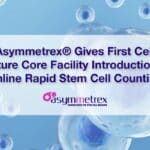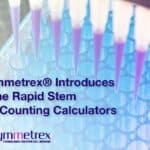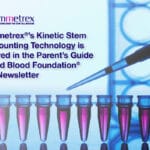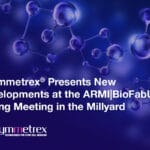Through the Development of a Universal Technology for Adult Stem Cell Production, Asymmetrex will Accelerate Regenerative Medicine.
Background for the “Suppression of Asymmetric Cell Kinetics (SACK)” Technology
Asymmetrex’s solution to the adult tissue stem cell production problem is based on a seminal insight by its founder. In a 2001 research report, Dr. Sherley and his research team accounted for a characteristic behavior of mammalian tissue cell cultures as the consequence of a biological process unique to adult tissue stem cells.
With time, the ability to propagate cultures of normal mammalian tissue cells is lost. Although for some mammals, like rodents, cultures may recover from this “crisis,” normal human tissue cell cultures do not. The time when human tissue cell cultures stop multiplying has been termed the “Hayflick limit” – after Leonard Hayflick, who first defined the phenomenon in the 1960’s.
The biological state of human tissue cell cultures propagated to the Hayflick limit is widely known as “senescence.” During the next four decades after Hayflick’s observations, senescence emerged as the leading precept to account for difficulty achieving indefinite culture of human tissue cells. Later, when new hopes from the late 1990’s for producing human adult tissue stem cells for regenerative medicine were dashed by many failures over the next two decades, senescence was also faulted.
The senescence concept that the multiplication properties of human tissue cells in culture are a projection of their properties in the body is correct. However, where the field of cell culture science went astray for many years was in treating tissue cells in culture as single homogeneous cell populations. Senescence has the implicit idea that all tissue cells have a similar multiplication clock that expires uniformly in culture. This was a costly error.
Although it was known for years that tissue cells in the body are, in fact, heterogeneous and arranged in hierarchical lineages, the senescence concept was not updated with this knowledge. Asymmetrex’s founding research innovation was updating the senescence concept for adult tissue stem cells in culture. This breakthrough in scientific thought inspired the technical breakthrough of “suppression of asymmetric cell kinetics” as a new technology for producing large numbers of adult tissue stem cells for regenerative medicine and drug discovery applications.
Watch a PowerPoint presentation on the Suppression of Asymmetric Cell Kinetics (“SACK”)
The SACK technology
Adult tissue stem cells are a small fraction of total tissue cells. They can divide to produce two new “sister” cells in either of two patterns. One of the division patterns is called symmetric self-renewal. Symmetric self-renewal divisions produce two new twin sister stem cells. Both new stem cells have the same stem properties of the stem cell that divided to produce them. Symmetric self-renewal is highly regulated during body growth and development. It occurs to increase the number of stem cell tissue units (see below) when the body is growing from infancy to adult maturity. Later in adult life, it occurs to restore tissue units lost to injury or disease. Abnormal unregulated symmetric self-renewal by mutated adult tissue stem cells can lead to cancer.
The second division pattern, asymmetric self-renewal, is the default pattern for adult tissue stem cells. Asymmetric self-renewal divisions produce a new stem sister cell and a non-stem sister cell. The non-stem sister goes by many names – e.g., lineage committed cell, transiently amplifying cell, differentiating cell, differentiated cell. In most tissues, characteristically, the non-stem sister will multiply extensively to produce the bulk of tissue cells – thousands more than the initiating stem cell. The many new cells produced follow a developmental program, which differs respectively for each different type of tissue, that yields the mature functional cells and physical structures that characterized organs and tissues – e.g., liver hepatocytes, skin, hair, nails, cornea, intestinal transport cells, neurons, lung bronchial lining cells. Another significant feature of these stem cell-based tissue units is that the mature cells and structures no longer multiply. So, they must be replaced by the continuous progression from stem cell asymmetric self-renewal division, to non-stem sister amplification and differentiation, to functional maturation.
In the body, this universal cellular hierarchical program of tissue maintenance, called asymmetric cell kinetics, provides many elements important for mammalian life and health. However, in the culture dish, it is the actual basis for cell culture senescence. In the body, tissue stem cells are held in defined adjacent locations, so that they are not diluted and lost among the vastly more numerous mature, dividing and non-dividing, functional cells that they normally produce. In contrast, in the culture dish, being now mixed uniformly with other tissue cells, they are rapidly lost by dilution when samples of cells from full cell culture dishes are transferred to new dishes for continued propagation. Once a new transfer culture dish receives no tissue stem cells, “senescence” is inevitable when the remaining non-stem cells reach their final non-dividing state of functional maturation.
Based on these ideas, the recognized solution for the adult tissue stem cell production problem was shifting tissue stem cells for asymmetric cell kinetics to symmetric cell kinetics. Called “suppression of asymmetric cell kinetics,” this feat of stem cell engineering would lead to exponential production of tissue stem cells and, perforce, sufficient repression of the production of differentiating cells to prevent senescence by tissue stem cell dilution.
In Asymmetrex’s founding research, a cellular pathway – involving the p53 cancer gene and inosine monophosphate dehydrogenase (IMPDH), the rate limiting enzyme for cellular production of guanine ribonucleotides – was discovered that regulated adult stem cell transitions between asymmetric self-renewal and symmetric self-renewal. Subsequently, compounds that increase cellular pools of guanine ribonucleotides were shown to be effective SACK agents. SACK agents like xanthine, hypoxanthine, and xanthosine are naturally occurring compounds found normally in the blood, organs, and tissues. Because their effects are non-toxic and reversible, when they are removed, expanded tissue stem cells resume their unique property of asymmetric self-renewal with production of mature functional tissue cells. Because asymmetric stem cell kinetics is a universal property of mammalian tissues, SACK technology has a wide range of potential applications in regenerative medicine and drug development.






Leave a Reply